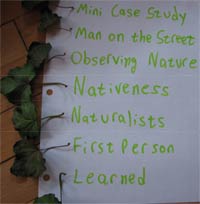| Class Site | Jay Silver |
A Case Study of Becoming an Explorer - Dec. 2007


 Comments
Comments
What was Learned |
|
Example of "New Ways of Perceiving"
Much of the students' ability to communicate natural processes relied on the visual world. Here's an example from Grant Jordan in 2003 -- he moved beyond the visible, mapping the wind by watching his warm breath in the cold air at each point in an alley way. |

|

|
New Ways of "Seeing"
Through Grant's awareness of the invisible, he was able to explain the pile of debris in the middle of the alley. It corresponds to the circle with the "x" in it from the picture above, and he says, "The center of the whirlwind can be seen (and shown to not be a temporary occurrence) by the deposits of debris..." |
| Grant was able to invent this "warm breath in the cool air" technique during the process of his exploration in the class, which is a nice case of someone learning to "see" the invisible. I wonder what the experience would have been like with a different kind of "camera". Shutsu talks about her experience with the camera guiding her through the North End. Ryan and Shutsu both talk about invisible processes, but when it comes to substantiating their concepts with observations, they point to visual cues of what they see. | |
|
Cameras for the Invisible?
They didn't touch or smell anything. I wonder how the process would differ if there were a camera-like tool that could help frame the nonvisual aspects of the landscape? If a camera is for the visual, what device would capture other sensory data like temperature? Ryan was able to talk about relative average temperature over the course of days through the presence or absence of snow on one side of the street vs. the other. What would Ryan do if he could sense temperature more directly and take a "picture" of some sort to help tell his story? What about the things in the environment that we can't sense at all, like C02? Could we take pictures of that? |

|
|
Conclusions
I do think the process these students underwent helped them to become more aware on a daily basis after the class was over. They have become urban explorers and know how to look for nature processes in an urban landscape. The process of returning to their site many times and observing for long periods of time helped them to become more intimate with the landscape and even motivated their observations further through piquing their interest. The use of a camera helped tremendously in communicating the students' obesrvations to the world on their websites. However, it's not totally clear that the cameras helped them to observe per se. Shutsu says the camera helped her decide what to observe next (how to focus her attention), and I definitely think that a camera helps you focus on making an observation by narrowing the field of what can be observed. This narrowing is a sort of scaffolding that's useful to get people going. But in framing it also encourages people to leave things out of the frame. The people in the class focused on visual cues almost to exclusion, with sound being a more common exception. It would be nice to have a suite of tools to scaffold/narrow the first-person obesrvation activities in a variety of ways. Since a 5-block area has a lot of activity in a city, too much to master, I'd also like to see what happens in a hyperlocal space smaller than a block. While there is some richness in allowing for the breadth of natural processes in a larger space, I do wonder what happens when a space is constrained. Do people develop more patience and watch for longer periods, pushing themselves into observations that span time as often as space? Do people push their methods of observation beyond those handed to them rather than apply the observations to more area? I think they might, and when I conduct my explorations of urban nature I may try limiting people to "their favorite spot" or "a set of a few _____'s" such as dumpsters or park benches. I'll leave you with a few thoughts of what the students learned. |
|
|
|
Looking Up
I think learning to look up is worth more than face value. It's learning to observe... it's learning to be aware. |
|
A Wealth of Local Knowledge
Ryan happens to be able to reason out when the building they were sitting it was built. |
|
|
Digging Deeper
Celina learned to ask questions of even the seemingly mundane. I don't know how you can "teach" that, but the process these students went through seems to have allowed them to discover it. |
|
Overview | Mini Case Study | Man on the Street | Observing Nature | Nativeness | Naturalists | First Person Obervation | What was Learned